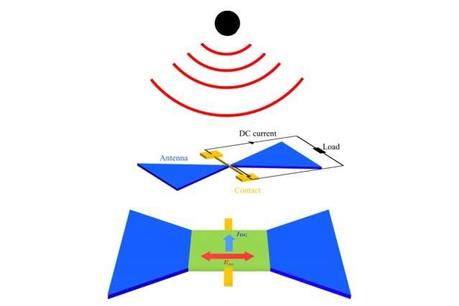Nowadays, Wi-Fi signals are everywhere. Every device that emits Wi-Fi signals also emits a kind of high frequency electromagnetic waves with a frequency range of somewhere in between microwaves and infrared light. These electromagnetic waves are known as “T-rays” or terahertz waves that can also be produced by our own bodies and the objects surrounding us that can record a temperature.
T-rays are everywhere in our surroundings if their concentrated power is utilized, they could serve as an alternate source of energy. For example, if a smartphone add-on can be created that soaks up the T-rays of the surroundings and use this energy to charge itself. However, till now we can’t harness this energy and is wasted because there has been no practical method to capture and convert these rays into a usable form.
Now a team of physicists at MIT have proposed a blueprint for a new device they believe would be able to generate electric power by converting ambient T-rays (terahertz waves) into direct current (DC).
Hiroki Isobe, lead author of the study and a postdoc in MIT’s Materials Research Laboratory said that,
“We are surrounded by electromagnetic waves in the terahertz range, if we can convert that energy into an energy source we can use for daily life, that would help to address the energy challenges we are facing right now.”
Their design takes advantage of the quantum mechanical, or atomic behavior of the carbon material graphene. They found that by combining graphene with another material, in this case, boron nitride, the electrons in graphene should skew their motion toward a common direction. Any incoming terahertz waves should “shuttle” graphene’s electrons, like so many tiny air traffic controllers, to flow through the material in a single direction, as a direct current.
“If a device works at room temperature, we can use it for many portable applications,” Isobe says.
They are using the principals of quantum mechanics or atomic behavior of graphene (carbon material). They found that by combining graphene with boron nitride, the waves should “shuttle” graphene’s electrons, like so many tiny air traffic controllers, to flow through the material in a single direction, as a direct current (a kind of current that flows in one direction, usually referred to as DC).
The team’s device is known as a terahertz rectifier and it’s made up of a small square of graphene with a layer of boron nitride underneath, flanked on both sides by an antenna. The antenna collects the terahertz radiation from the surrounding air, boosting the signal while passing it onto the graphene. That, in turn, causes the electrons in the graphene to all flow in the same direction, creating a direct current.
 A schematic showing how the terahertz rectifier would work. The red lines are terahertz waves, the blue triangles are the antenna, and the green square is graphene, Image Courtesy of the researchers
A schematic showing how the terahertz rectifier would work. The red lines are terahertz waves, the blue triangles are the antenna, and the green square is graphene, Image Courtesy of the researchers
The boron nitride layer helps keep the graphene as pure as possible since any impurities would send the electrons scattering. Usually, the electrons in graphene would be forced equally in all directions, but the boron and nitrogen atoms in the lower layer redirect their path just enough to keep them all moving together.
Also read: The Genius Nikola Tesla’s Top Inventions
While it’s possible that any terahertz rectifier would only produce a small amount of electric current, it could be enough to power small devices at first. The team suggests that the first application might be for powering implanted devices for example pacemakers, which currently require surgery to change the batteries.
As Mr. Isobe envisions that, in the near future, terahertz rectifiers may be used, for example, to wirelessly power implants in a patient’s body, without requiring surgery to change an implant’s batteries. Such devices could also convert ambient Wi-Fi signals to charge up personal electronics such as computers and smartphones.
The researchers have published their results in the journal Science Advances, and are closely collaborating with experimentalists to turn their design into a real physical device.

